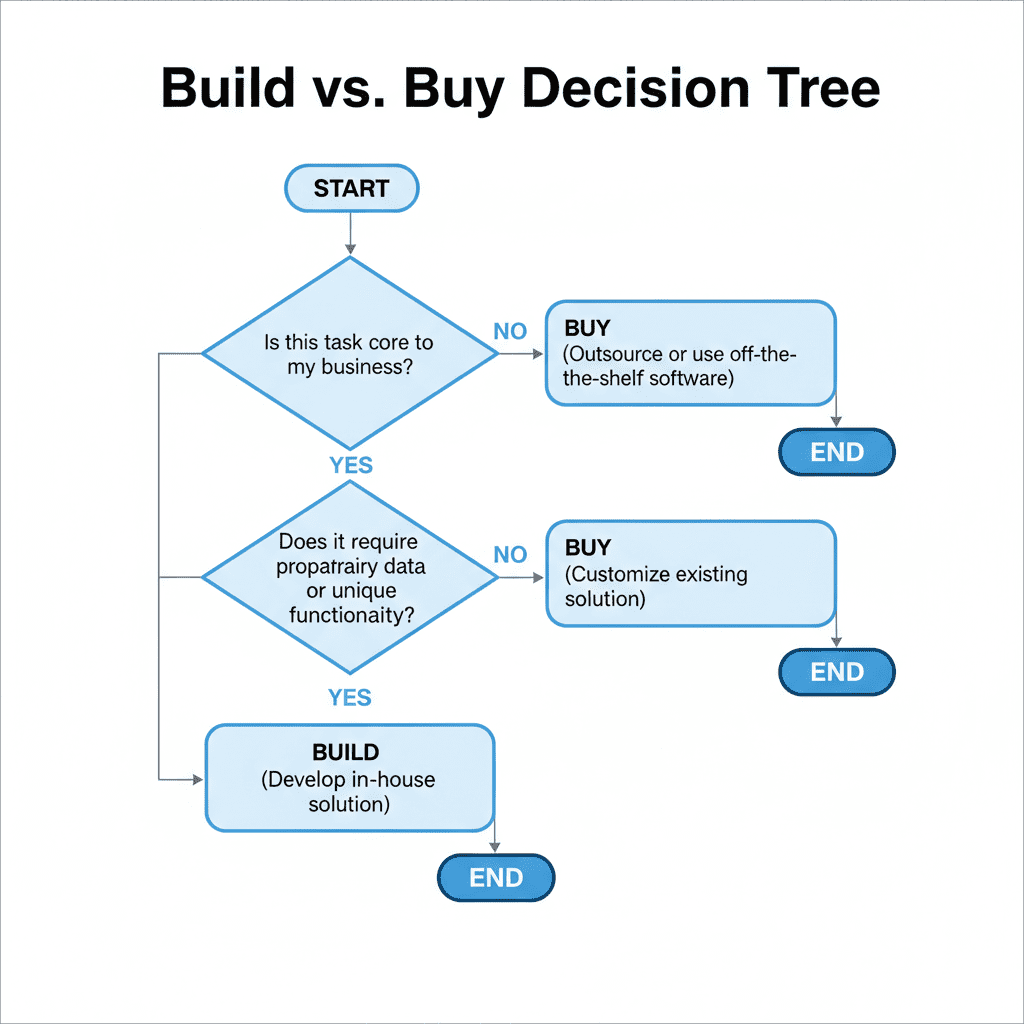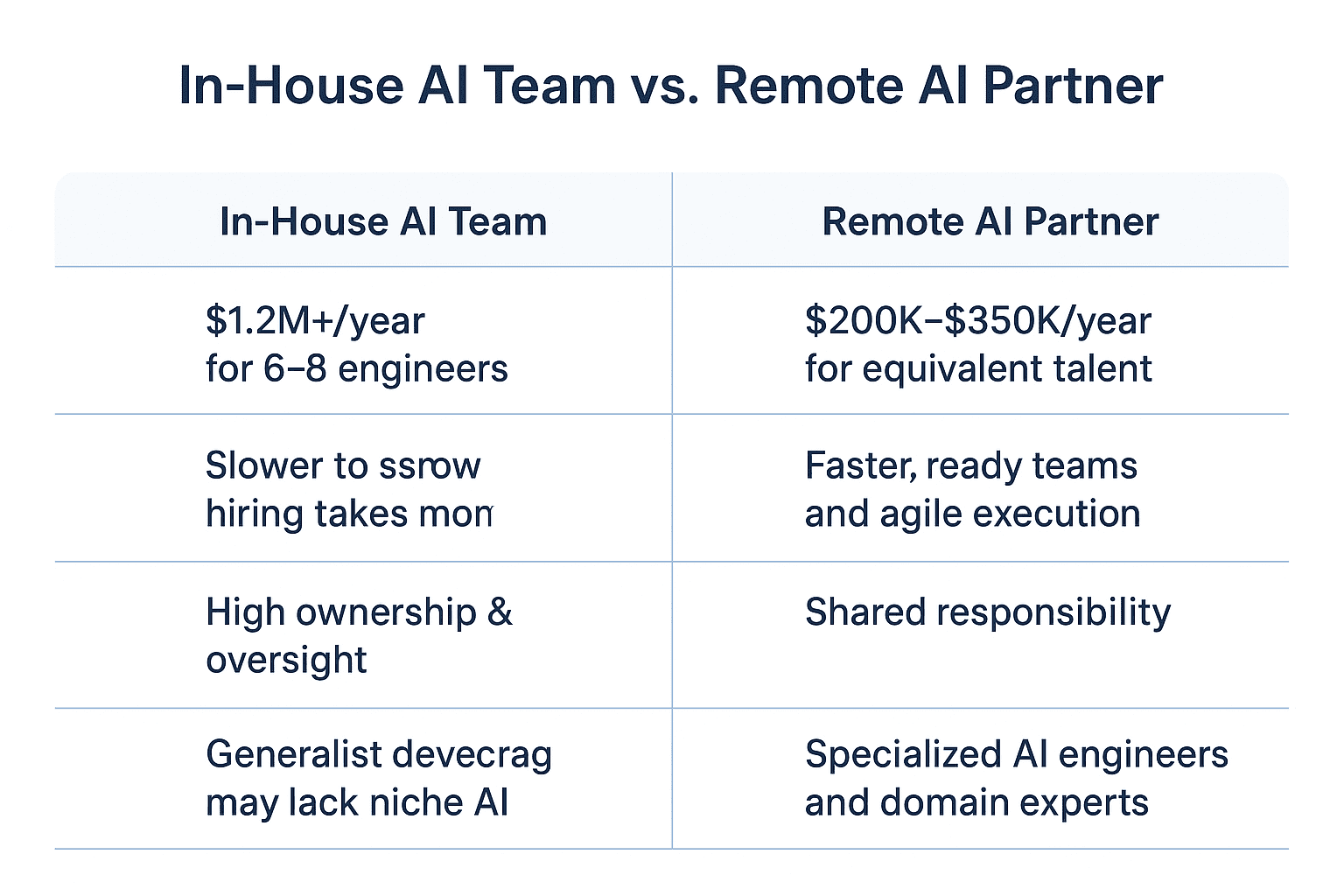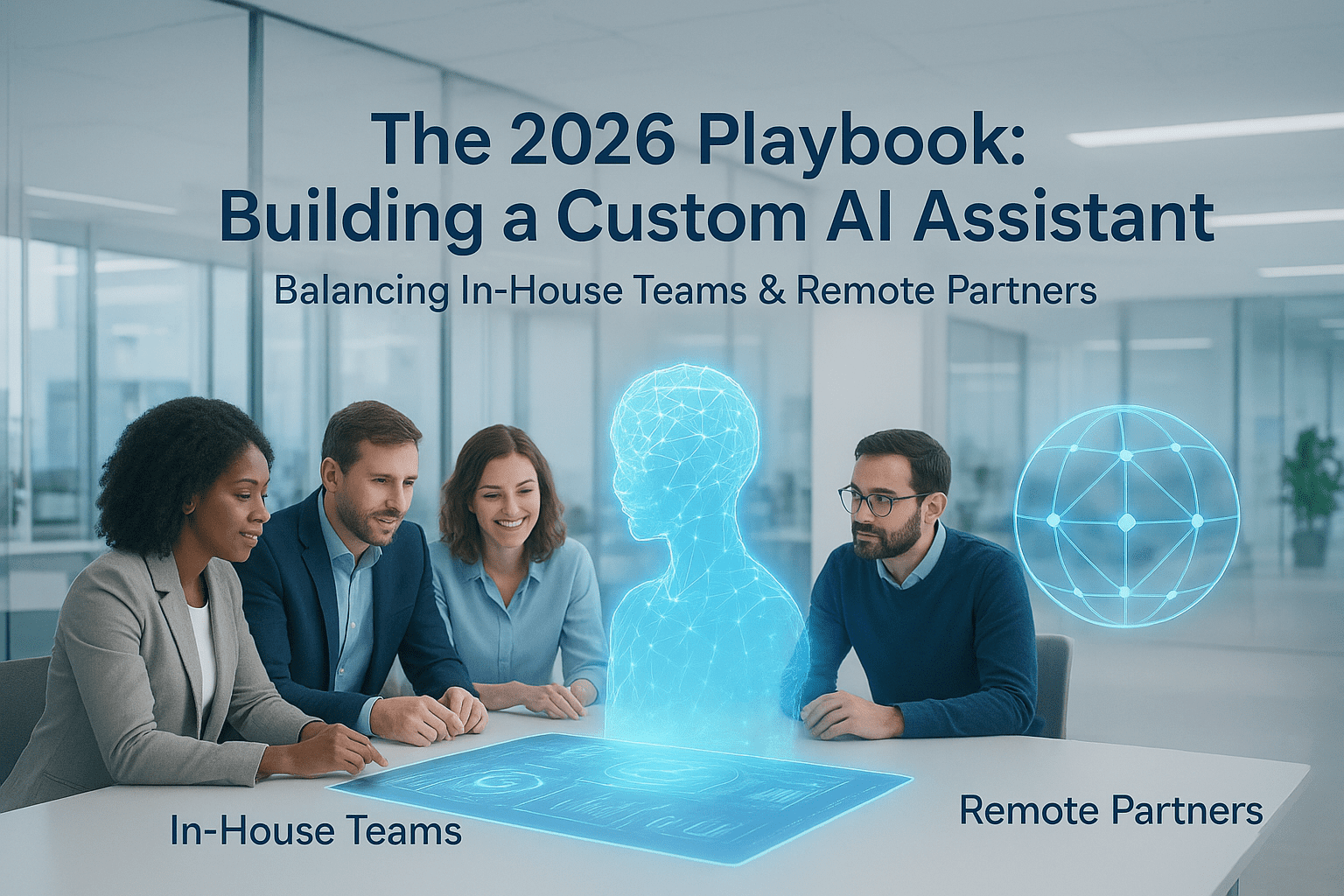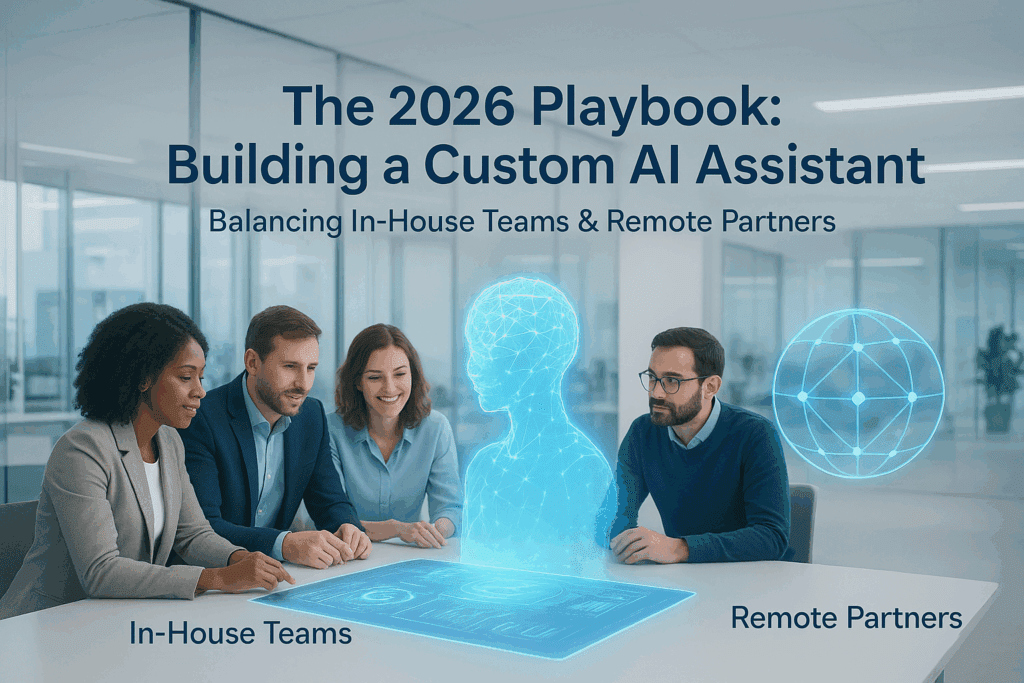Introduction: Why 2026 is the Year of Custom AI Assistants
AI assistant development in 2026 is no longer just a futuristic idea — it’s a practical playbook for startups and enterprises. The AI gold rush is the defining transformation of the present. In 2023, ChatGPT and Gemini mainstreamed AI adoption. By 2025, AI became integrated into daily workflows across enterprises. But as we enter 2026, businesses face a sharper question:
👉 Will you rely on the same off-the-shelf AI tools as your competitors, or will you build a proprietary AI assistant that becomes your enduring competitive edge?
The answer increasingly points to custom-built AI assistants:
- Trained on your proprietary data
- Tailored for your workflows and customers
- Designed to differentiate your product in the market
But building one requires making a pivotal strategic choice: Do you hire an in-house AI team or partner with a specialized remote development team?
This playbook provides the CTO’s ultimate guide to making that decision. We’ll explore:
- The strategic tradeoff between building and buying
- The modern AI assistant architecture for 2026
- A step-by-step development roadmap
- A data-driven cost, speed, and risk comparison between in-house vs. remote teams
By the end, you’ll know exactly how to approach building your organization’s AI future, as AI development in 2026 will be more like a crucial requirement for most organizations.
Chapter 1: The Strategic Fork in the Road – Build vs Buy
Before writing a single line of code, every CTO must decide whether to buy an off-the-shelf AI tool or build a proprietary assistant.
When to Buy (Off-the-Shelf SaaS):
- ✅ Fast deployment
- ✅ Minimal upfront cost
- ✅ No maintenance overhead
Best for: Generic tasks (FAQ chatbots, meeting summarizers, writing assistants).
Limitations:
- ❌ No competitive differentiation (everyone has the same tool)
- ❌ Limited customization
- ❌ Potential data exposure (sending sensitive data to third parties)
When to Build (Custom AI Assistant):
- ✅ Leverage proprietary data (internal docs, CRM, support history)
- ✅ Deliver unique customer experiences competitors can’t replicate
- ✅ Ensure data sovereignty and compliance (finance, healthcare, defense)
- ✅ Deep workflow integration into existing systems (ERP, CRM, custom apps)

Chapter 2: Anatomy of a Modern AI Assistant (2026 Tech Stack)
A custom AI assistant development in 2026 is not possible from scratch — it’s assembled from modular, best-in-class technologies.

1. The Brain (LLM – Large Language Model)
- APIs (Titans): GPT-4/5, Claude 3/Opus, Gemini Ultra → easy to use, powerful, expensive.
- Open-Source (Challengers): Llama 3, Mistral → cheaper, customizable, requires MLOps expertise.
2. The Memory (RAG – Retrieval Augmented Generation)
- Stores and recalls proprietary knowledge.
- Powered by vector databases: Pinecone, Weaviate, Chroma.
- Example: Support agent AI pulling the right snippet from a 50,000-ticket history.
3. The Orchestration Layer (The Glue)
- Frameworks: LangChain, LlamaIndex
- Manages LLM prompts, connects to APIs, and orchestrates multi-step reasoning.
4. The Application Layer (The Body)
- Backend: Node.js / Python APIs
- Frontend: React/Next.js web apps, React Native mobile apps
- Integrations: Slack bots, CRMs, internal dashboards
Chapter 3: The 5-Step Roadmap to AI Assistant Development in 2026
An AI assistant development in 2026 follows a lean, iterative cycle:
- Define Use Case & Metrics
- Example: “Reduce average ticket resolution by 30% by automating 50% of inbound queries.”
- Prepare Data
- Identify your “source of truth” (docs, PDFs, DBs)
- Clean, normalize, and structure data for ingestion
- Proof of Concept (2 Weeks)
- Connect an LLM + small dataset with LangChain
- Validate feasibility before investing in UI or scale
- Full App Development (8–12 Weeks)
- Backend + Frontend + APIs
- Workflow integrations
- Deploy, Monitor & Iterate (Ongoing)
- A/B testing, logging AI responses, user feedback loops
Chapter 4: The Million-Dollar Decision – In-House vs Remote Partner
Once you validate the vision, you must decide who builds it.
Option A: In-House AI Team (Traditional Path)
Roles Needed & Salaries (US Average 2025–26):
- AI/ML Engineer: $220K–$350K
- Senior Backend Developer: $150K–$220K
- Senior Frontend Developer: $140K–$200K
- DevOps/MLOps Engineer: $160K–$230K
- Product Manager: $150K–$210K
Challenges:
- $1.2M+ annual loaded cost
- 6–9 months to assemble
- Locked into specific skill sets
- High risk if direction changes
Option B: Specialized Remote Partner (Agile Path)
Partnering with a vetted remote team (like GlixenTech) flips the economics:
- Start in Weeks, Not Quarters
- Fraction of the Cost (less than a single Bay Area AI engineer)
- Access to Pre-Built Expertise in RAG, LLMOps, LangChain, cloud infra
- Scalable on Demand (expand during build, shrink during maintenance)

Chapter 5: Frequently Asked Questions (FAQs)
1. How do we ensure our proprietary data remains secure with a remote partner? This is paramount. A credible partner like Glixentech operates under strict NDAs, employs secure coding practices, and utilizes secure cloud infrastructure (AWS/GCP/Azure) with robust access controls. We ensure your data is handled with the same level of security as you would in-house.
2. What is a realistic budget for building an MVP of a custom AI assistant? While this varies, building an MVP with a specialized remote team is significantly more accessible. Instead of a seven-figure upfront investment, projects can often start in the range of a US-based senior developer’s quarterly salary, allowing you to prove value before scaling your investment.
3. Our company data is messy. Can we still build an AI assistant? Absolutely. In fact, most company data is messy. The first phase of any AI project (“Step 2” in our roadmap) is dedicated to data discovery, cleaning, and preparation. Our teams are experts in building the data pipelines needed to transform your raw information into high-quality fuel for your AI.
4. How long does it actually take to build a functional MVP? With a focused use case and a prepared dataset, a dedicated remote team can often deliver a functional MVP—one that solves the core business problem—in as little as 12-16 weeks. This is a stark contrast to the year or more it can take when starting with in-house hiring.
5. What happens after the AI assistant is launched? Do you offer support? Yes. Launch is just the beginning. We offer flexible, ongoing support and maintenance packages to monitor performance, fix bugs, ingest new data, and iteratively add new features based on user feedback. We partner for the entire lifecycle of the product.
Conclusion: The Future Belongs to Custom AI Assistants
2026 marks the turning point: AI is no longer a tool — it’s a strategic asset.
CTOs who build proprietary AI assistants will:
- Unlock competitive moats with exclusive, data-driven intelligence
- Achieve speed-to-market advantages over slower competitors
- Control costs, security, and differentiation
While building in-house may suit enterprises with massive budgets, the agile, capital-efficient path is partnering with a specialized remote team.
Don’t just deploy AI. Build your next competitive advantage.






